Strangely enough, Tamsui Fisherman’s Wharf (淡水漁人碼頭) lacks restaurants serving the fresh catch of the day. Most of the shops along this scenic dock, a short ferry ride from Danshui MRT Station (淡水捷運站), are either newish-looking Western-style cafes serving pasta or outdoor stands offering night market fare such as fried chicken and oyster omelets.
For fresh seafood, you have to walk across Lover’s Bridge (情人橋), a pedestrian walkway that is the area’s main attraction, and head to Ocean King Palace (深海魚餐廳), located in a two-story building near the wharf’s parking lot.
With its large dining hall and round tables, Ocean King serves dishes suited for a traditional Taiwanese banquet meal, or pantoh (辦桌, from the Hoklo pronunciation, which literally means “setting up tables”). The restaurant would indeed be a fitting place for a wedding celebration, and the food, like a lot of traditional wedding or pantoh meals, can be hit or miss.
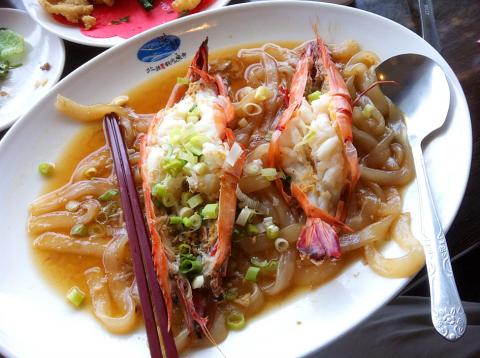
Photo: David Chen, Taipei Times
We ordered the wild ocean jumbo shrimp (野生海大蝦, NT$320 for two pieces) with our waiter’s recommendation, but came away disappointed. The steamed shrimp was rubbery and overcooked. This was a shame because it was served on a bed of Hakka-style flat rice noodles (客家板條) with a tasty dressing: freshly chopped scallions, smashed garlic and a soy broth sauce. Everything was right — except for the shrimp itself.
Humbler concoctions like the deep-fried oysters (炸蚵仔酥, NT$180) and deep-fried squid (酥炸鮮軟絲, NT$180) proved to be the favorites at our table. Beneath the crispy batter coating, you could taste how fresh the squid and the oysters were. Infused with basil and black pepper, in keeping with the classic Taiwanese deep-fry method, these dishes were melt-in-your-mouth delicious and go perfectly with either a bottle of Taiwan Beer (台灣啤酒, NT$60, per bottle) or Gold Medal Taiwan Beer (金牌台灣啤酒, NT$70).
Ocean King also offers a selection of sanbei (三杯) or “three cups” dishes, which are commonly cooked in an earthenware pot with a cup of rice wine, a cup of sesame oil and a cup of soy sauce. Our party enjoyed the three cups tender tofu (三杯嫩豆腐, NT$180), which lived up to its name. The tofu was creamy smooth with a light pan-fried crisp on the outside, and garnished with basil and garlic.
Other sanbei dishes include the “three cups chicken” (三杯燒土雞, NT$300) and “three cups eel” (三杯活錢鰻, NT$500).
I was unimpressed by the steamed king grouper (清蒸龍膽石斑魚, price changes daily), which was supposed to be one of the restaurant’s better choices for fresh fish. This turned out to be similar to the shrimp: a bit overcooked.
The meal can be rounded off with a fried rice or noodle dish, which are available in a variety of meat combinations that include pork, shrimp and beef, and cost NT$160 each. The portions are big enough for two. Or for something a little fancier, order the rice porridge with grouper fish and fresh seafood (石斑海鮮粥, NT$300), which the waitstaff says is better suited to larger parties. Fresh vegetable stir-fry dishes range from NT$120 to NT$160.
The first time I visited Ocean King Palace, I wished it were closer to the oceanside instead of being situated near the wharf’s parking lot. The restaurant is housed on the second floor of the Tamsui Fish Market (淡水魚市) building, which might actually look charming if it weren’t for the obnoxious, brightly lit sign for the Subway sandwich store also on the second floor.
However, it’s possible to enjoy the ocean breeze while having a meal at Ocean King Palace, which has a balcony with an outdoor seating area, where you can watch tourists roaming across Lover’s Bridge and gaze at Guanyin Mountain (觀音山) in the distance.
I wouldn’t recommend a trip to Ocean King Palace merely to satisfy a craving for a seafood meal. The food is overpriced, presumably because the area mainly caters to tourists.
Still, the restaurant is the only one in the neighborhood offering a celebratory meal, Taiwanese style.
Buses run directly to Fisherman’s Wharf from Danshui MRT Station, but the ferry is a much more pleasant and relaxing ride and only takes around 15 minutes from the nearby Old Street area (淡水老街).
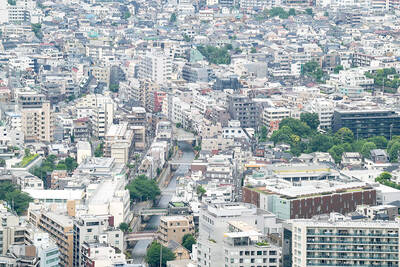
The canonical shot of an East Asian city is a night skyline studded with towering apartment and office buildings, bright with neon and plastic signage, a landscape of energy and modernity. Another classic image is the same city seen from above, in which identical apartment towers march across the city, spilling out over nearby geography, like stylized soldiers colonizing new territory in a board game. Densely populated dynamic conurbations of money, technological innovation and convenience, it is hard to see the cities of East Asia as what they truly are: necropolises. Why is this? The East Asian development model, with
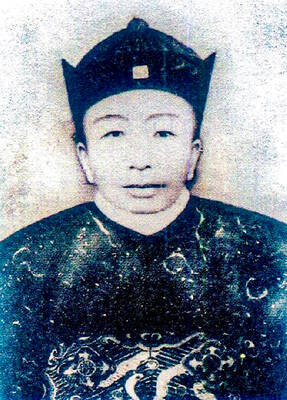
June 16 to June 22 The following flyer appeared on the streets of Hsinchu on June 12, 1895: “Taipei has already fallen to the Japanese barbarians, who have brought great misery to our land and people. We heard that the Japanese occupiers will tax our gardens, our houses, our bodies, and even our chickens, dogs, cows and pigs. They wear their hair wild, carve their teeth, tattoo their foreheads, wear strange clothes and speak a strange language. How can we be ruled by such people?” Posted by civilian militia leader Wu Tang-hsing (吳湯興), it was a call to arms to retake
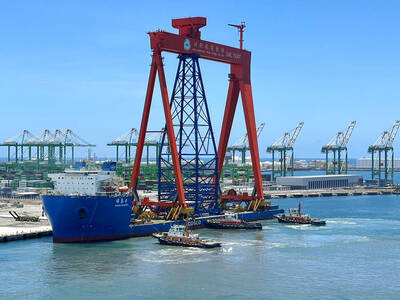
This is a deeply unsettling period in Taiwan. Uncertainties are everywhere while everyone waits for a small army of other shoes to drop on nearly every front. During challenging times, interesting political changes can happen, yet all three major political parties are beset with scandals, strife and self-inflicted wounds. As the ruling party, the Democratic Progressive Party (DPP) is held accountable for not only the challenges to the party, but also the nation. Taiwan is geopolitically and economically under threat. Domestically, the administration is under siege by the opposition-controlled legislature and growing discontent with what opponents characterize as arrogant, autocratic
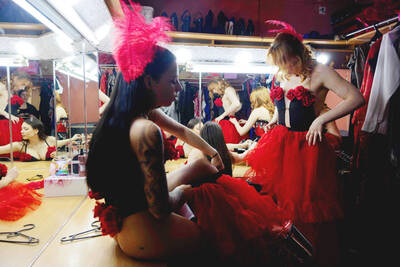
When Lisa, 20, laces into her ultra-high heels for her shift at a strip club in Ukraine’s Kharkiv, she knows that aside from dancing, she will have to comfort traumatized soldiers. Since Russia’s 2022 invasion, exhausted troops are the main clientele of the Flash Dancers club in the center of the northeastern city, just 20 kilometers from Russian forces. For some customers, it provides an “escape” from the war, said Valerya Zavatska — a 25-year-old law graduate who runs the club with her mother, an ex-dancer. But many are not there just for the show. They “want to talk about what hurts,” she